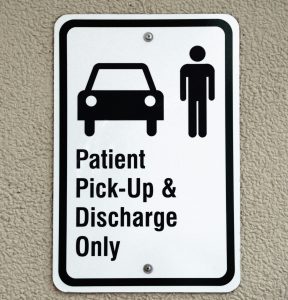Chapter 9: Transfer and Discharge Procedures
Discharge Routines
Discharge Planning
A discharge is when a patient is released from a health care facility by physician orders and can be applied to patients returning home, moving to a long-term care facility, or another health care facility (Thompson, 2018).

Discharge planning starts at the time of admission or, in the case of patients having elective surgery, prior to admission during the preoperative visit at the pre-surgical clinic. As a crucial component of the patient flow effort, discharge planning takes the following factors into account including the patient’s medical diagnosis, the discharge plan (home, long-term care, or another hospital), any equipment needed (hospital bed, walker, raised toilet seat), services needed (home care, home oxygen), prescriptions, follow-up visits, and transportation needs if the patient is unable to drive themselves.
The HUC may be involved in many different aspects of the discharge planning including processing physician referrals for discharge planning and organizing patient services, referrals, equipment, and transportation.
Discharge Orders
A documented doctor’s order from the MRP is required for a patient to be discharged. Discharge orders may be written prior to the discharge date, or on the day of discharge. It is not uncommon for the physician to discuss the pending discharge with staff and/or the patient, without actually writing the order. In this case, it is essential to confirm that the patient is being discharged and that the formal discharge order is on the patient’s record prior to the patient leaving. It is often the HUC’s role to track down the MRP or the doctor on call when there is no order written (Thompson, 2018).
Hospitals typically plan for patients to be discharged in the morning. There are two reasons for this:
- Some provincial plans are charged for another day of hospital stay if the patient is not discharged by noon (Thompson, 2018).
- The first scheduled patients of the day undergoing elective surgery will require admission to post-op operative units by the late morning.
However, given the shortage of hospital beds, patients may be discharged in the afternoon or evening if a physician makes rounds then and signs a discharge order.
Leaving Against Medical Advice (AMA)
Capable patients have the right to leave, refuse treatment, or end treatment by leaving the hospital without a physician’s order. While this may occur occasionally in an inpatient department, it is more common in areas such as the Emergency Department, when wait times are long. Any patient leaving the hospital unit without a formal discharge order must be asked to sign a release of responsibility form stating that they understand that they are leaving without permission and that they are assuming all responsibility for the ensuing outcomes. However, it is not uncommon for patients to leave without checking in at the communication centre, or to refuse to sign release forms.
If a patient approaches the communication centre stating that they are leaving without a discharge order, the HUC should seek assistance from the clinical resource nurse or nursing staff. If there are no staff readily available, the HUC should listen empathetically and attempt to redirect them to their room to await a nurse. If the patient insists on leaving prior to a nurse arriving, the HUC should ask them to sign a release of responsibility form and carefully document the conversation as per facility policy. It is essential that the MRP is notified immediately when a patient leaves against medical advice, so their office may follow up as necessary.
The HUC’s Role in Patient Discharges
Once the HUC receives the discharge order, they should
- enter the pending discharge in the bed board, communication board, and patient information screen (if using),
- assemble routine discharge instructions for the patient, including prepared discharge teaching instructions and medication handouts,
- note any follow-up appointments on the discharge record, including the date and phone number of care providers,
- print or copy all relevant medical information including doctor’s orders, progress records, medication records, and consultations and put in a sealed envelope if the patient is being discharged to another care facility,
- book urgent or non-urgent patient transportation as required (see next section),
- ensure that all valuables, clothing, and home medications are returned to the patient or family,
- fax the patient’s prescriptions to their pharmacy if required,
- dissemble the patient’s p-Chart if using, and arrange in the correct order for HIM processing,
- cancel dietary tray,
- discharge the patient in the clinical information system when they physically leave the unit,
- notify family if required, and
- notify housekeeping/environmental services that the room is ready to be cleaned (the computer system may automatically do this on discharge).
The HUC will often be approached by patients at discharge asking for assistance in removing their armbands. Unless otherwise instructed, the HUC should instruct patients that this should remain on until they physically leave the hospital.
References
Thompson, V. D. (2018). Administrative and clinical procedures for the Canadian health professional (4th ed.). Pearson Canada.
Attributions
“Patient Pick-up & Discharge Only Signage” by Pixabay; used under the Pexels license.
a physician's order to release a patient from a health care facility

